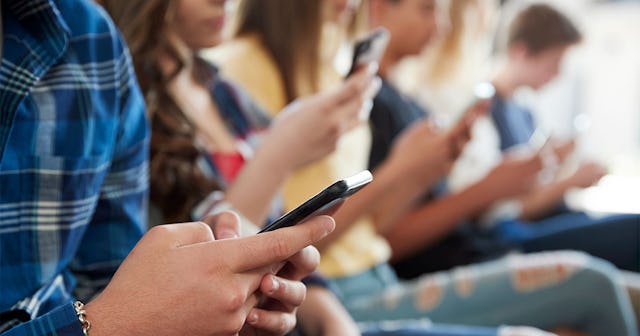TikTok Isn't Toxic — School Is Where The Real Problem Lies

Here in the U.S., kids are stealing soap dispensers from school. Well, to be more accurate, students stealing and destroying school property, often in the bathrooms, is one of the latest student fads. Think breaking mirrors, clogging toilets, and damaging sinks and urinals. Oh, and then there’s the “Kool Aid” end of the craze, which involves red dye sprayed all about the stalls, presumably to to imitate blood — and leaves stains.
Administrators, teachers, police, and parents are blaming it on a TikTok trend that features the hashtag #DeviousLicks. “Lick” is slang for theft.
American K-12 campuses are flailing to figure out this fresh hell. Consequences include locking up bathrooms (for both prevention and repair), confiscating phones as evidence, increasing hallway monitoring, and even forbidding students from leaving classrooms to get water. School counselors and security are being pulled from their daily duties. Personally, I’d like to hear what the custodians have to say.
Where are we going and why are we in this hand basket?
Hear me out: It’s our own fault, and we shouldn’t be surprised.
No, I’m not excusing poor behavior. These students are making immature, destructive, just-plain-stupid choices. That’s one part of a fair assessment.
For us “authority” figures — parents, school staff, government — it’s often our default to react to this bad behavior with hurt feelings and anger. How could they be so disrespectful? So reckless? That, or we try to feel better by shaking it off. “Kids will be kids.”
But that doesn’t mean we shouldn’t ask why. All behavior is communication. Vandalism is abnormal behavior. Where impulsivity can be categorized as age-appropriate, mindless destruction cannot. So to not figure out root causes for this deviant behavior would be, for adults, irresponsible, reckless, and just-plain-stupid.
Outside of our disappointment and frustration, adults need to see the obvious: #DeviousLicks is a protest. A crappy, poorly executed version of a protest.
It’s not a huge leap to draw a line between all that our students have endured in the past 18 months and how disconnected they feel from their school communities; however, our school system went septic long before Covid entered the picture. This student behavior speaks loudly, though somewhat inarticulately, to how toxic school culture is in America. And we can’t blame TikTok for that.
Year after year, American communities have agreed that more mental health support is needed in our schools. And year after year, we’ve skipped it, cut funding for it, or put a Band-Aid on it by assuming saintly educators will fill the counselor gap — a more-than-full-time job on its own that they are not qualified or trained for.
Anxiety in young people is astronomical; rates of youth depression are through the roof. According to the National Institutes of Health, one in three adolescents will experience an anxiety disorder. Between 2007 and 2012, anxiety disorders in children and teens went up 20%. In the past decade, rates of hospitalization for suicidal teenagers has doubled.
There are lots of reasons we can point to for the endemic anxiety and depression in our youth. Increased screen time. Social media. Surging terrorist attacks. Society’s massive, ostracizing political, racial, and capitalistic divides. I mean, just to name a few.
At least monthly, K-12 students practice sitting in complete silence, away from a locked classroom door with the lights off. For high school seniors, this practice for active shooters (played down as “lock-down drills”) has been a part of their routine since kindergarten. Ask any teacher, and they’ll tell you which furniture they’d use to barricade their doors and windows. Many educators have attended professional development workshops on wound packing, tourniquets, and blood loss.
This was all before the pandemic hit. Our schools — already chronically underfunded and facing critical staff shortages — shut down for weeks and went virtual for semesters, if not the full year, and continue to need to do so as needed. The system we’ve designed to build our country’s future was far from prepared to deal with the complicated blows that the past 18 months has dealt — they were already hanging on by a thread.
Fast forward to today, and we’re upset that our students don’t feel ownership and pride over their school community? We’re shocked that they aren’t more protective of their shared school environment?
You’ll have to excuse me for being blunt. Why the hell should they?
The kids are not alright. The educators are not alright. They’ve been crying for help for a long time, and we’ve offered them band aids, thoughts, and prayers. So while I don’t condone vandalizing school property, I do see it for what it really is: frustration and pent-up despair for a system that’s done them dirty.
Of course, students are stealing soap dispensers. Stop acting surprised and start asking why — or prepare for worse as we continue to shortchange tomorrow.
This article was originally published on